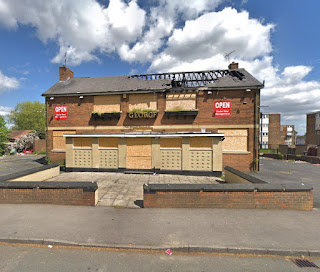A couple of days ago saw a rather sad milestone when I posted the 1000th entry on my Closed Pubs blog. This was The Pagefield Hotel, a magnificent late Victorian or Edwardian edifice in a residential area just outside Wigan town centre. One or two of the pubs I have posted have subsequently reopened, but the vast majority haven’t, and it serves as a sad testimony to the decline of the pub trade.
I started this blog in August 2010, prompted by the creation of the Google StreetView app, which provided images of street scenes across the UK. Initially it was like shooting fish in a barrel, as I recorded all the closed pubs I was personally familiar with. In October 2010 I made 30 posts, virtually one a day. After a while, it slowed to a trickle, with only 4 posts in 2015, but after that I became more assiduous in seeking out new ones, and was helped by suggestions and photographs from various contributors.
Amongst these I will particularly thank the late Peter Allen, who was responsible for the Pubs Then And Now blog, Staffordshire resident Dan Bishop, and Yorkshire residents Luke H and Kyle Reed. In the past few years, Kyle has been a very prolific contributor, which helps explain the substantial number of entries in West Yorkshire. Yorkshire as a whole is about to overtake Staffordshire in terms of number of entries, and is not far behind Lancashire.
In general, I haven’t aimed to give any background, and just described what I see from the image, although in many cases I found about the pub from a news article which I have linked to, and which provides some more information. Many of these came from the Fullpint news aggregation Twitter account, which unfortunately stopped posting for some reason in May this year.
It was generally recognised thirty years ago that there were around 70,000 pubs in the UK, so 1,000 represents over 1% of the total, and that’s only a drop in the ocean. I have logged 117 pubs in (historical) Cheshire – assuming there were maybe 1,500 pubs in the county, that makes up 7.8%.
There can be no doubt that a slow-motion catastrophe has overtaken the British pub trade. There has been a profound change in the way people use pubs, which in most instances has meant that they no longer do any more. Most of this is down to changes in social attitudes, but of course the smoking ban was a wound deliberately inflicted by government. Some may respond that times have changed, and new pubs and bars have opened up, which is true enough. But they are on a much smaller scale than before, and overall there has undoubtedly been a huge contraction in the trade.
Ten years ago I wrote a post entitled Trying to make sense of it all which attempted to explain the tidal wave of closures. The conclusion was that pretty much all sectors of pubs were affected, with only a limited number of niche areas seemingly immune.
The most common category seems to be the post-war estate-style pubs, which for a variety of reasons never seem to have really worked, something I wrote about here. Possibly the whole concept was flawed from the start, and arose more from town planners’ tidy minds than actual drinkers’ needs. It would not surprise me if fully half the purpose-built, stand-alone pubs constructed after the war are no longer trading, in some cases lasting less than twenty years.
But the big inter-wars pubs, often built to much higher standards of design and construction, are in a sense the saddest. A prime example is The Beeches in Northfield, Birmingham, which resembles a magnificent Jacobean stately home. StreetView shows that it had been demolished by May 2011, and housing has now been built on the site.
Will there be another 1,000 pubs on the blog? Only time will tell, although there are certainly enough candidates out there waiting to be discovered. If you’re aware of any, please let me know, although I do need either a photograph or a StreetView link showing it in a boarded up or derelict state.














